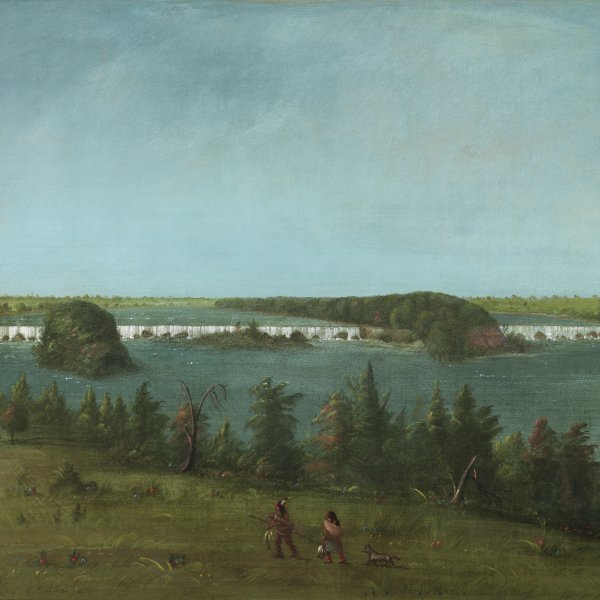George Catlin
Wilkes-Barre, 1796-Jersey City, 1872
George Catlin has gone down in history as the painter of American Indians. After reading law he practiced as an attorney, but soon decided to take up painting as a self-taught artist. He worked as a portraitist and miniaturist from 1823 to 1829 and enjoyed such success that by 1824 he had been elected a member of the Pennsylvania Academy of Fine Arts.
In 1826 Catlin decided to document the native population of the United States. For this purpose he travelled to the Saint Louis area in 1830 and was the first painter to join General William Clark’s expeditions to unexplored regions of the continent, such as Wisconsin in 1830, the river Missouri in 1832 and the Falls of Saint Anthony in 1835, where he came into contact with many tribes. Using the sketches made during these travels, he depicted scenes of the life and customs of the tribes and painted portraits that are almost anthropological in nature. He also produced a series of publications on the customs and ways of life of the North American Indians, the first of which came out in 1841. In addition, he became a collector of all kinds of objects, which he grouped together with his paintings in his Indian Gallery.
The first exhibition of the Indian Gallery was held in New York in 1837 and was subsequently shown in other cities around the United States. In 1840, after a failed attempt to sell it to the state, Catlin travelled to Europe, showing it in London and Paris. Two of his works were later displayed at the Paris Salon of 1846, where they caught the attention of Charles Baudelaire and Eugène Delacroix. Catlin’s debts led him to spend some time in prison and forced him to sell the Indian Gallery to the American businessman Joseph Harrison, who stored it in a warehouse. It was finally presented to the Smithsonian Institution.
Catlin travelled to South America in the mid-1850s. On returning to Brussels, where he was living at the time, he produced a series of cartoons reproducing his Indian Gallery and incorporated South American themes. After a thirty year absence from his country, in 1870 Catlin returned to New York, where he exhibited his new collection, without success.
In 1826 Catlin decided to document the native population of the United States. For this purpose he travelled to the Saint Louis area in 1830 and was the first painter to join General William Clark’s expeditions to unexplored regions of the continent, such as Wisconsin in 1830, the river Missouri in 1832 and the Falls of Saint Anthony in 1835, where he came into contact with many tribes. Using the sketches made during these travels, he depicted scenes of the life and customs of the tribes and painted portraits that are almost anthropological in nature. He also produced a series of publications on the customs and ways of life of the North American Indians, the first of which came out in 1841. In addition, he became a collector of all kinds of objects, which he grouped together with his paintings in his Indian Gallery.
The first exhibition of the Indian Gallery was held in New York in 1837 and was subsequently shown in other cities around the United States. In 1840, after a failed attempt to sell it to the state, Catlin travelled to Europe, showing it in London and Paris. Two of his works were later displayed at the Paris Salon of 1846, where they caught the attention of Charles Baudelaire and Eugène Delacroix. Catlin’s debts led him to spend some time in prison and forced him to sell the Indian Gallery to the American businessman Joseph Harrison, who stored it in a warehouse. It was finally presented to the Smithsonian Institution.
Catlin travelled to South America in the mid-1850s. On returning to Brussels, where he was living at the time, he produced a series of cartoons reproducing his Indian Gallery and incorporated South American themes. After a thirty year absence from his country, in 1870 Catlin returned to New York, where he exhibited his new collection, without success.





